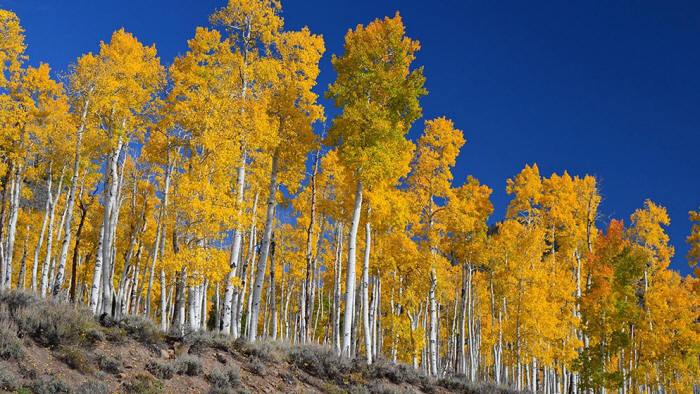|
by Jasna Hodić September 30, 2022 from BigThink Website
Credit: J Zapell / Public domain
Wikipedia
a stand of aspen in Utah that is 14,000 years old and weighs 12 million pounds.
Humans threaten to
end its long reign...
Scientists estimate that this grove of quaking aspen contains nearly 47,000 individual trees - all male and all with the same DNA.
Pando's root system is estimated to be thousands of years old, with habitat models placing its maximum age at 14,000 years
But Pando's long reign is under pressure.
The aspen stand has
weathered millennia of biological pressure, but a combination of
grazing, human development, and drought threatens to stress Pando to
the point of no return.
In 2021, Rogers returned to take new measurements of Pando, and he reported even more grim news.
According to his results, published in the journal Conservation Science and Practice, Pando is not growing fast enough to keep up with over-browsing, and human attempts to help might be making the problem worse.
Scientists do not know why, but they think it may be related to the seed's finicky germination requirements. In general, aspens reproduce asexually.
Sprouts emerge directly
from an extensive network of underground roots, meaning each
separate tree is just one of thousands of stems growing from a
single clone.
If an older stand dies, a
younger layer should be ready to replace it. When aspens are damaged
by a disturbance like herbivory, the clone sends a signal to the
roots to make more sprouts.
Rogers told The New York Times,
Along with capturing key metrics, Rogers also compared historical aerial footage to modern photos.
His survey made the reality crystal clear:
Rogers knew Pando was contracting because it had no young sprouts to replace older trees as they died. He suspected that the culprits were mule deer and cattle.
These animals browse Pando's young shoots and decimate them before they can reach a developmental stage robust enough to withstand the ungulates' depredations.
We have steadily
encroached on Pando over the last few decades, building telephone
poles, campgrounds, and roads. The constant development and
maintenance of these areas can provide ideal forage for mule deer,
who like to snack on low-lying forest leaves and shoots.
Humans aggressively
hunted the wolves, mountain lions, and grizzly bears that can help
keep the mule deer in check. Those populations are still recovering
and have not returned to the populations they boasted before hunting
began.
The grove now is split into three parts:
The 2014 fence was built from older materials to save money.
This fence quickly fell
into disrepair, and mule deer could easily get around, so it was
repaired in 2019.
As Rogers writes,
So not only does the stubborn trend of limited stand replacement persist in Pando, but by applying three treatments to a single organism, we also encouraged it to fracture into three distinct entities.
The stumble makes sense - it is hard to understand whether fencing will work unless we compare the treatment to a control group.
But the strategy does show our failing to understand Pando as one entity:
The obvious solution may be to fence off all of Pando, but this idea presents many problems.
Caging the whole stand would affect many animals and plants in and around Pando. Plus, the process would require inordinate amounts of active management.
Finally, do we really want to fence in a beautiful, emblematic forest as if we were keeping it locked away in a zoo?
Rogers writes,
Aspens are considered keystone species, as they facilitate high levels of biodiversity.
For example, aspens
provide understory shade to the benefit of many species of mammals,
birds, and vegetation. Their understory also holds a great deal of
water, making forests more resilient to wildfire.
For example, Rogers found that Pando's overstory has been steadily diminishing.
Less canopy cover allows more light to penetrate to Pando's understory, changing the composition and diversity of the plants and animals at the ground level.
He writes,
Rogers stresses that we must focus our efforts on what he calls process-based restoration.
Instead of controlling browsing in the short term with fencing, we need to reorient the whole ecosystem back toward its natural predator-prey dynamics, emulating biological processes to whatever degree possible.
This approach might include reintroducing predators, allowing for more aggressive hunting of ungulates, and stopping livestock grazing.
Such interventions require multiple agencies to coordinate.
That is hard to pull off, but it's the only way to bring about lasting changes.
Pando's preservation may not be the top priority on the long list of global conservation issues. However, Pando shows how human interactions, even when well intentioned, can throw a delicate system out of alignment.
The success of adaptive,
process-based management at Pando could inform conservation projects
worldwide.
|


